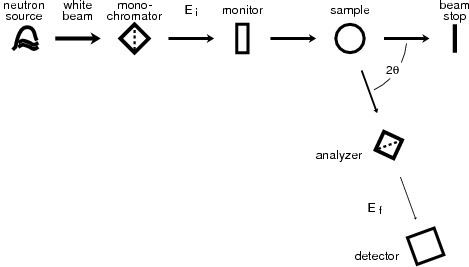 | ||
Inelastic neutron scattering is an experimental technique commonly used in condensed matter research to study atomic and molecular motion as well as magnetic and crystal field excitations. It distinguishes itself from other neutron scattering techniques by resolving the change in kinetic energy that occurs when the collision between neutrons and the sample is an inelastic one. Results are generally communicated as the dynamic structure factor (also called inelastic scattering law)
Inelastic scattering experiments normally require a monochromatization of the incident or outgoing beam and an energy analysis of the scattered neutrons. This can be done either through time-of-flight techniques (neutron time-of-flight scattering) or through Bragg reflection from single crystals (neutron triple-axis spectroscopy, neutron backscattering). Monochromatization is not needed in echo techniques (neutron spin echo, neutron resonance spin echo), which use the quantum mechanical phase of the neutrons in addition to their amplitudes.
